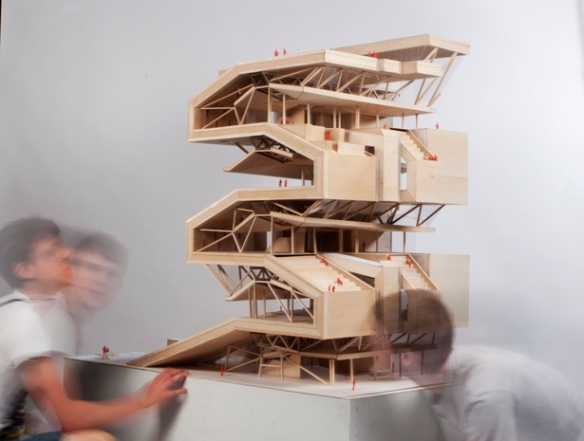We are kicking off the week with a project fresh off the Design Development studio walls of RPI by Tyler Hopf & Alex Dorn. The RPI studio of Design Development spring boards off the unrealized designs, such as in this case UNStudio’s Mediatheque circa 2005, where the students take the original design proposal and complete a SD set for the project. A great introduction into what it takes to actually structure and bring these designs to realization. Check it out after the jump!
SCHOOL: Rensselaer Polytechnic Institute
STUDENTS: Tyler Hopf & Alex Dorn
COURSE: Design Development – UNStudio – NEWER ORLEANS
YEAR: Fall 2012
The superNODE brings landscape up and into the building intersecting with the extension of the urban environment.
The superNODE exists as a positive cultural icon, safe haven, and a playground to stimulate cultural vitality in post-Katrina New Orleans. This mediatech acts as a node of culture in the city, harboring communication and exchange through media and public assembly.
The string warps and deforms as a reaction to the program of the building. This allows it to perform in a multi-scalar way, creating opportunities for concerts and rallies with thousands of people, performances in the auditorium for hundreds, and smaller gatherings in lecture halls, classrooms, and private reading spaces for information exchanges at every scale.
Three urban conditions are established in the site and building: the public plaza, public park, and sidewalk. The plaza as an open space for gathering is established at the west side, continuing into the building’s interior. The public park continues up and into the building on the east side creating a continuous flow with the context and smaller scale elevated terracing. The sidewalk condition is created on the mezzanine levels as an overflow
space of the programs on the main floors and as a consistent connector for the shifting strings.
Program is defined in two axes, vertically through cultural character (perform, project, converge, commerce, and exchange) and horizontally through the action within (observe, catalog, assemble, create/workshop, individualize).
The two sides of the string enhance the separation of program and multi-scalar functionality of the building by creating alternating pockets of space
and distinguishing between the two orientations of the building.
F+ Orginal Submitted by Tyler Hopf














